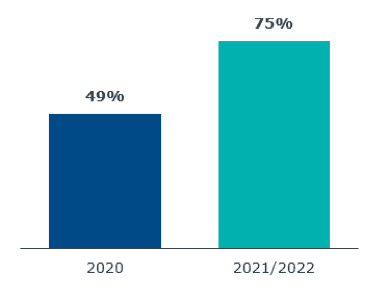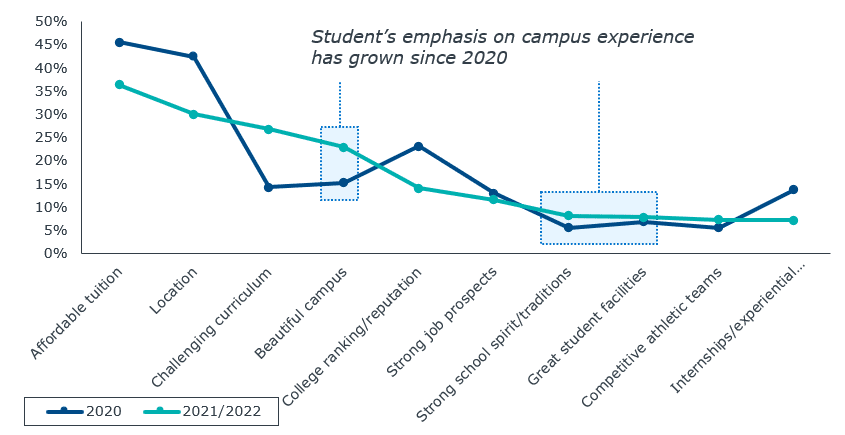3 ways the pandemic has changed Gen Z's college search behavior
I spend a lot of time speaking with enrollment leaders who are concerned about the future. As a former practitioner myself, I understand their anxiety about meeting enrollment goals. And things have only gotten more uncertain with all the volatility created by the pandemic, in part due to changes in students’ behavior and preferences.
To help enrollment leaders understand just how students’ mindsets are shifting, EAB conducts ongoing survey research and closely analyzes student interactions with our marketing. Our latest report on our New College Freshman survey sheds light on the ways that Gen Z’s journey to college has changed due to the pandemic.
Research Methodology: Student-Reported and Observational Data
4,848
High school students who graduated in 2021, with data collected in winter 2022. (New College Freshman Survey Responses)1.5B+
Student interactions that EAB analyzes annually from across our partner institutions. (Observed Student Behavioral Data)Download our full report on Gen Z’s evolving enrollment journey
1. Parent influence is higher than ever
Students name parents and families as a highly important source of information in their college decision, second only to college websites. In fact, since 2019, the percentage of students naming parents and families in their top five sources has increased, with a huge jump from 2020 to 2021/2022. With students spending more time at home with families during the pandemic and less time at schools interacting with teachers and counselors, it’s not surprising that parents played a larger role in 2021 than ever before.
Percentage of Students Naming Parents or Guardians in Their Top 5 Sources

Our research also shows that parents’ level of influence varies across different demographic segments. Lower-income students are less likely to rely on parental support than higher income students, as are Black or Hispanic students compared to Asian or White students. We also found that first-generation students are far less likely to name their parents as a top source for college information than their non-first-generation peers.
Learn how to recruit underserved students better
Percentage of Students Naming Parents or Guardians in Their Top 5 Sources

-
TAKEAWAY:
While we don’t yet know whether parental influence will stay at pandemic-era levels, it’s safe to say that parents will likely remain instrumental to students’ decision-making. To build affinity with that very important group, enrollment leaders should build robust parent communication channels through email streams and digital ads. In addition, institutions should keep in mind that many of the top sources listed by students, such as personal letters and campus visits, are also effective channels for reaching and influencing parents.
2. Virtual tours are helping reduce access gaps
The pandemic accelerated Gen Z’s adoption of virtual tours, helping them become a staple of today’s recruitment experience. Whereas in 2020, less than half or surveyed students had attended a virtual tour, by 2021/2022, 75% had done the same. Even with a strong return to on-campus visits, we expect virtual tours to continue to play a central role in Gen Z’s college search since they cater to their desire for self-directed, flexible, and easily accessible sources.
Virtual Tours Have Exploded in Popularity
Students Attending at Least 1 Virtual Tour

Our research also supports one of the commonly cited benefits of virtual tours: that they help improve access to campus for students who may not have the resources or flexibility to visit in-person. Students with family incomes of more than $120,000 per year were 83% more likely to have visited more than 3 schools in person than families making $60,000 or less. In contrast, with virtual tours, the gap in usage across income groups shrinks to 56%.
Income Disparities Across All Visit Types
Students Who Went on >3 Visits

-
TAKEAWAY:
While it’s encouraging that virtual tours help level the playing field, our data indicates that some disparity remains. Ensure you’re proactively promoting your virtual tours to lower-income and under-served students to help them get a better sense of your campus.
3. Students are seeking a vibrant campus experience
Unsurprisingly, our research showed that financial concerns remain the top factor in students’ choice of college. However, we noticed an interesting trend in other factors that students consider when choosing a school: they now place more weight on their campus experience than they did at the start of the pandemic. Students ranked “beautiful campus,” “school spirit and traditions,” and “student facilities” more highly in our most recent survey than they did in 2020. After a year or more of lockdowns and Zoom classes, students are eager to immerse themselves in campus life.
“Why did you select the school where you are enrolled?”
Top 10 Responses, Participants Could Pick Up to 3

Our research also looked to students’ assessment of their time at college so far. Student satisfaction levels took a big dip in 2020 when many campuses were shut down, but they ticked back up to pre-pandemic levels for students entering college in 2021. Whether students are satisfied or dissatisfied, our research shows that classes, social life, and campus are the top factors in their opinion. It’s important to note that, while students are generally more content with their college choice now than previously, 60% of students still don’t feel extremely satisfied or dissatisfied. This group is one to watch closely, given the important role that retention plays in meeting campus enrollment goals.

-
TAKEAWAY:
Today’s students want a fun and immersive post-pandemic experience from their college. Play up your vibrant campus life in student communications. In addition, support retention efforts at your institution by sharing satisfaction data with student success stakeholders.

More Blogs

Students are applying to more colleges than ever before: What this means for your enrollment strategy

7 myths about transnational education

Why brand management is your best bet for fighting higher ed’s image problem
Great to see you today! What can I do for you?